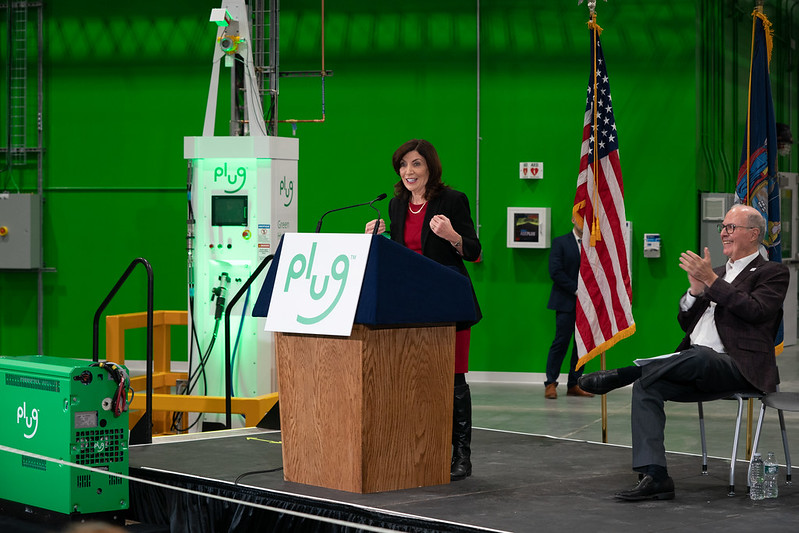
Gov. Hochul talks clean energy (photo: office of Governor Kathy Hochul)
It’s time to Upgrade New York.
Last summer Governor Hochul signed the Utility Thermal Energy and Jobs Act, sponsored by Senator Kevin Parker and Assemblymember Latoya Joyner, which passed unanimously in the Senate and nearly unanimously in the Assembly. This first-in-the nation law — supported by the New York State Building and Construction Trades Council, New York State AFL-CIO, utilities, climate justice organizations, building industry representatives, and environmental groups — is a critical first step to rapidly decarbonizing our buildings at a neighborhood scale with Thermal Energy Networks, while preserving and creating middle class jobs. The transformational law is being duplicated in a number of states here in 2023.
Now, the Legislature can and must build off this success to Upgrade New York.
During Climate Week, the Governor proclaimed New York must lead by example and directed state agencies to adopt a BuildSmart NY program, administered by the New York Power Authority, to achieve significant emissions reductions from state-owned buildings, campuses and facilities by 2025. Buildings are the largest source of emissions in New York state, contributing over 32% of all pollution. Rapidly eliminating on-site emissions from the state’s buildings should be a top priority as the state seeks to meet its ambitious climate goals.
One of the largest owners of buildings in New York is the state itself – with a buildings portfolio of more than 400 large campuses and facilities that spans across every region, each with multiple buildings that rely on oil and gas for heat, hot water, and cooling. Some of the highest emitting facilities include Empire State Plaza; Upstate & Downstate Medical Centers; SUNY Stony Brook, Albany, Buffalo, and Binghamton; and CUNY’s Brooklyn, City and Hunter Colleges.
The Legislature can lead by example to upgrade New York this session and mandate that all state buildings, facilities, and campuses fully decarbonize by eliminating on-site emissions by 2040. The Legislature can deliver immediate results by approving the funding necessary to ensure that projects to eliminate on-site emissions from 15 of the highest-emitting state-owned campuses are shovel-ready by 2025 – which would cut the overall pollution from state-owned buildings by 40%.
Because these high-emitting state campuses and facilities have multiple buildings, they are prime candidates for Thermal Energy Networks (TENs). TENs connect multiple buildings together with each other in a shared network that allows transfer of energy with thermal sources like geothermal boreholes, surface water, and even wastewater. TENs are super high efficiency systems that won’t strain the electric grid even during peak seasons. More importantly, TENs provide a true transition for the very workforce that currently install and maintain fossil fuel equipment and piping systems.
Investing in and building TENs at state facilities and campuses will serve as anchors that will preserve and create middle-class jobs and will ensure New York’s union workforce will be at the forefront of the state’s clean energy transition.
In order to ensure long-term careers for existing and new union members, the Legislature should include robust labor standards and require at least 40% of overall investments and benefits from the work of decarbonizing state, buildings, facilities, and campuses go to residents of New York communities disproportionately impacted by climate change (DACs) as defined under New York’s Climate Law. Utilizing the NYC Building and Construction Trades model of direct entry into apprenticeship programs will allow residents of DACs to gain access to union careers and a pathway to the middle class.
Creating this pipeline of work to decarbonize over 400 campuses and facilities over the next decade is a critical first step that will lead to jobs, recruitment into unions’ direct entry programs, pre-apprenticeship program grants, stipends, and wrap-around services to remove barriers. A long-term pipeline of work is sensible policy that creates the necessary workforce certainty that is required to determine training needs, recruit workers into programs, train workers in time, and build the highly trained workforce necessary to decarbonize our state.
The Legislature can lead again and enact this budget to appropriate the necessary funding, establish requirements for 15 state campus and facility shovel-ready projects by 2025, and mandate that all state-owned buildings facilities and campuses eliminate on-site emissions by 2040.
By doing so, legislators can chart the next frontier to build healthier, climate-resilient communities and create equitable middle-class union careers that ensure New York has the skilled workforce of tomorrow to realize our clean energy future.
***
Lisa Dix is the New York Director of the Building Decarbonization Coalition. John Murphy is the International Representative for the United Association of Plumbers, Pipefitters and Sprinkler Fitters in NY.
***
Have an op-ed idea or submission for Gotham Gazette? Email This email address is being protected from spambots. You need JavaScript enabled to view it.




